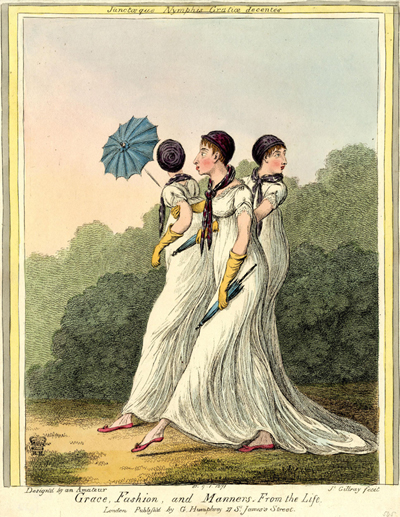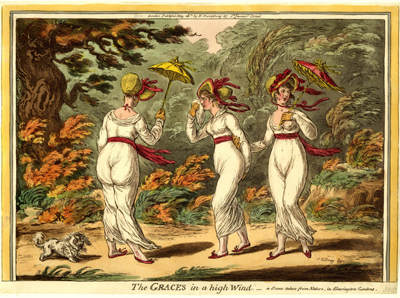Grace, Fashion, and Manners
This print, designed by an amateur and etched by Gillray, is generally agreed to represent the three eldest daughters of Sir William Manners (1766-1833), later (after 1821) styled Lord Huntingtower. The daughters include Louisa Elizabeth (1791-1830), Catherine Camilla (1792-1863), and Emily Frances (1793-1864) striding elegantly through a park-like setting. The title, Grace, Fashion, and Manners thus functions (as titles often do in portrait caricatures) as a clue to the figures represented.

© Trustees of the British Museum
The latin quotation above the image, "Junctaeque Nymphis Gratiae decentes" comes from Book I Ode IV of Horace's Odes addressed to Sestius which describes the Nymphs and Graces joining together to celebrate the return of Spring.
Now Cytherean Venus leads out her dancers, under the pendant moon, and the lovely Graces have joined with the Nymphs, treading the earth on tripping feet, while Vulcan, all on fire, visits the tremendous Cyclopean forges.
The quote thereby reinforces the title in associating the Manners sisters with the three classical Graces and also suggests that the scene is intended to represent a park in Spring.
Though the print is undated and was apparently unpublished until George Humphrey took over the Humphrey printing shop after Hannah Humprey's death in 1818, it was probably created in May of 1810 at around the same time as another print The Graces in a High Wind, published on May 26, 1810, and sometimes thought to portray the Manners sisters as well. Assuming an 1810 creation date for Grace, Fashion, and Manners, the Manners sisters would have been 19, 18, and 17 respectively—ages consistent with their appearance in the print.

© Trustees of the British Museum
There are several similarities between the prints. Both show three young women in the high-waisted, clinging muslin dresses associated with the French Empire style. In both prints, the women are roughly the same age, pictured out of doors in a park-like setting, carrying parasols. In both, the women are associated with the three mythological Graces. And finally, both make use of an etching roller much more than Gillray was accustomed to doing in earlier prints where his hand and eye were surer.
But there are also obvious and not so obvious differences. Grace, Fashion, and Manners is essentially a portrait caricature, taken "From the Life." There is little or no satiric edge here. The background, though clearly meant for out of doors, is, as in most portrait caricatures, undistiguished so that the focus remains on the three sisters.
The Graces in a High Wind, on the other hand is essentially a satiric caricature, parodying "high art" portrayals of the mythological Graces, and criticizing the highly revealing nature of women's fashion, similar to earlier Gillray satires such as Ladies Dress, As It Soon Will Be (January 20, 1796), and The Fashionable Mamma, or the Convenience of Modern Dress (February 13, 1796).
The question then arises: If Grace, Fashion, and Manners was created in 1810 why was it not published until 1818/19? Why was the much more outrageous The Graces in a High Wind printed and the much more restrained Grace, Fashion, and Manners withheld?
Barring the discovery of Gillray correspondence on the print, we are unlikely to get a definitive answer. Gillray was a sick man by 1810 and uncreasingly unreliable. One explanation may be that this print, commisioned by "An Amateur," was simply never finished (to Gillray's satisfaction at least). Or, alternatively, the print may have been, in effect, squashed by Sir William Manners. Manners had a reputation for being arrogant, vindictive, and pushy where claims of his own and family were concerned. If the print did not originate with him or meet with his approval, he may well have insisted that Gillray and Hannah Humphrey stop work on it. Years later George Humphrey may have been unaware of any such agreement and unintentionally printed it as part of a number of requests for Gillray's "Complete Works." And finally (and most speculatively), if Grace, Fashion, and Manners was indeed abruptly halted in Sir William's typically belligerent manner, Gillray may have been provoked to retaliate with The Graces in a High Wind which bears just enough resemblances to the forbidden print to have caused it to be associated by Wright and Evans with the Manners/Tollemache families, yet without specific evidence that could be used against Gillray and Humphrey.
Sources and Reading
- Commentary from the British Museum on Grace, Fashion, and Manners.
- "Charites," Wikipedia
- "William Tollemache, Lord Huntingtower (1766-1833)," Wikipedia
- "MANNERS, Sir William," The History of Parliament
- Horace's Odes, Book 1 Ode 4
- Thomas Wright and R.H. Evans, Historical and Descriptive Account of the Caricatures of James Gillray #573.
- Thomas Wright and Joseph Grego, The Works of James Gillray, the Caricaturist; With the History of His Life and Times, p. 370.
Comments & Corrections
NOTE: Comments and/or corrections are always appreciated. To make that easier, I have included a form below that you can use. I promise never to share any of the info provided without your express permission.